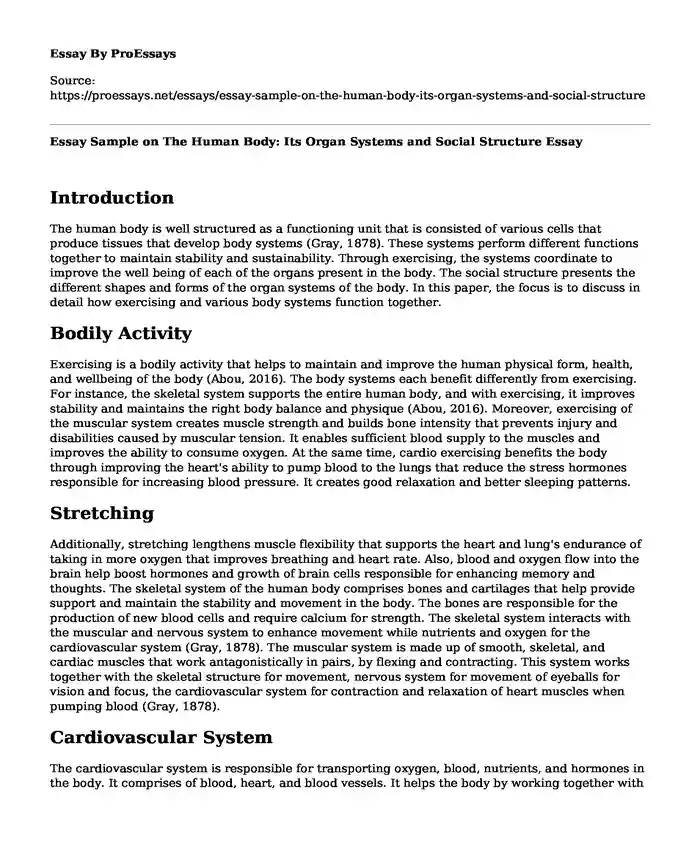Introduction
The human body is well structured as a functioning unit that is consisted of various cells that produce tissues that develop body systems (Gray, 1878). These systems perform different functions together to maintain stability and sustainability. Through exercising, the systems coordinate to improve the well being of each of the organs present in the body. The social structure presents the different shapes and forms of the organ systems of the body. In this paper, the focus is to discuss in detail how exercising and various body systems function together.
Bodily Activity
Exercising is a bodily activity that helps to maintain and improve the human physical form, health, and wellbeing of the body (Abou, 2016). The body systems each benefit differently from exercising. For instance, the skeletal system supports the entire human body, and with exercising, it improves stability and maintains the right body balance and physique (Abou, 2016). Moreover, exercising of the muscular system creates muscle strength and builds bone intensity that prevents injury and disabilities caused by muscular tension. It enables sufficient blood supply to the muscles and improves the ability to consume oxygen. At the same time, cardio exercising benefits the body through improving the heart's ability to pump blood to the lungs that reduce the stress hormones responsible for increasing blood pressure. It creates good relaxation and better sleeping patterns.
Stretching
Additionally, stretching lengthens muscle flexibility that supports the heart and lung's endurance of taking in more oxygen that improves breathing and heart rate. Also, blood and oxygen flow into the brain help boost hormones and growth of brain cells responsible for enhancing memory and thoughts. The skeletal system of the human body comprises bones and cartilages that help provide support and maintain the stability and movement in the body. The bones are responsible for the production of new blood cells and require calcium for strength. The skeletal system interacts with the muscular and nervous system to enhance movement while nutrients and oxygen for the cardiovascular system (Gray, 1878). The muscular system is made up of smooth, skeletal, and cardiac muscles that work antagonistically in pairs, by flexing and contracting. This system works together with the skeletal structure for movement, nervous system for movement of eyeballs for vision and focus, the cardiovascular system for contraction and relaxation of heart muscles when pumping blood (Gray, 1878).
Cardiovascular System
The cardiovascular system is responsible for transporting oxygen, blood, nutrients, and hormones in the body. It comprises of blood, heart, and blood vessels. It helps the body by working together with the respiratory system for oxygen and carbon dioxide movement and with the nervous system to regulate blood pressure and heartbeat (Gray, 1878). The respiratory system is responsible for providing the body with oxygen from the environment for respiration and expulsion of carbon dioxide from the lungs. Without oxygen, most cells begin to die, and the heart stops transporting oxygen to the lungs. Hence, the respiratory and cardiovascular system work conjointly. The nervous system regulates breathing and advocate smell and taste. The nervous system coordinates all the body functions since it contains the brain and all the nerves. The body's response to the environment is through the mind, and it works with all the other body systems (Gray, 1878).
Conclusion
In conclusion, the movement and structure of the human body are organized in different systems that have other functions but work together to ensure the body's growth and stability. These systems also help the body by protecting it from damage and maintaining general wellbeing.
References
Abou Elmagd, M. (2016). Benefits need and importance of daily exercise—International Journal of Physical Education, Sports, and Health, 3(5).
Gray, H. (1878). Anatomy of the human body (Vol. 8). Lea & Febiger.
Cite this page
Essay Sample on The Human Body: Its Organ Systems and Social Structure. (2023, Oct 15). Retrieved from https://proessays.net/essays/essay-sample-on-the-human-body-its-organ-systems-and-social-structure
If you are the original author of this essay and no longer wish to have it published on the ProEssays website, please click below to request its removal:
- Essay on Yoga for Overall Good Health
- Adversarial Relationships: How to Create Better Relationships
- Paper Example on Blunt Force Injuries
- Health Care Provider Work Hours and Sleep Deprivation Paper Example
- The Welfare of Animals Used in Science: How the "Three Rs" Ethic Guides Improvements
- Research Paper on Pathophysiology of Schizophrenia
- Essay Sample on Drug Info: Misleading Consumers or Evidence-Based?







